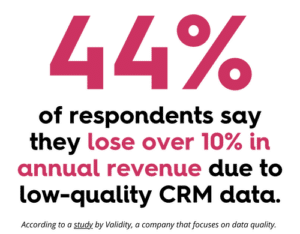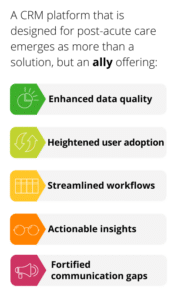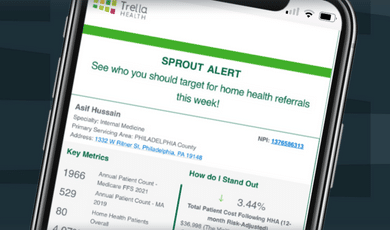When implementing an effective Customer Relationship Management (CRM) platform, the journey toward success is often met with formidable obstacles.
As your organization strives to harness the full potential of a CRM platform, you may experience one of five barriers that may emerge – each posing unique challenges to seamless CRM utilization.
The 5 barriers discussed are:
- Data quality and management
- Lack of user adoption
- Workflow inefficiencies
- Missing insights and reports
- Communication gaps
Join us as we unravel these barriers to help your organization overcome these barriers and pave the way for CRM utilization success.
Let’s dive in!
CRM Barrier #1: Tackling Data Quality and Management
Navigating the complexities and features of a Customer Relationship Management (CRM) platform can sometimes bring your organization face-to-face with a critical barrier: data quality and management.
As you know, a CRM is an invaluable tool for your sales reps to stay organized and on track with their day-to-day activities. However, a CRM’s true purpose is compromised if your organization has multiple databases and scattered or incomplete information.
Let’s look at some of the consequences:
Potentially Missed Opportunities
With multiple databases or fragmented data, your sales team could overlook significant referral opportunities.
Decisions Based on Inaccuracies
Incomplete or inaccurate information can lead to poor decision-making, thus impacting the accuracy and reliability of a sales rep’s data-driven conversation with a top referral source.

Revenue Loss
The most substantial consequence to your organization can come in the form of revenue loss.
According to a study by Validity, a company that focuses on data quality, “44% of respondents say they lose over 10% in annual revenue due to low-quality CRM data.”
Yes, you read that correctly – 10% of annual revenue is LOST because of data quality issues.
Remember: A CRM isn’t just a tool – it should be a solution that helps empower your sales reps for success, not hinder them.
CRM Barrier #2: Why Your Team Isn’t Embracing the CRM Platform
The path toward an effective CRM often encounters a significant barrier – lack of user adoption.
While it’s enticing to have the latest and greatest CRM with all the bells and whistles – its actual value lies in its adoption and utilization by the organization.
Did you know?
A staggering 43% of CRM users exercise less than half of the available features. This underutilization highlights a substantial untapped potential within the CRM platform.
So, why do sales reps hesitate to fully embrace their CRM despite offering extensive features?
Below are a few challenges your reps may be facing with a new CRM:
Complex interface
Sales reps may resist using a new CRM if seen as complex and challenging to navigate – creating a sense of daunting complexity.
Lack of training
Insufficient training can hinder adoption – leaving your sales reps feeling unequipped to use the CRM efficiently and effectively.
Time-consuming
Inefficient workflows within your CRM can create bottlenecks – affecting your sales reps’ productivity and leading to resistance.
Intrusive Perception
Your CRM may be seen as a “big brother” tracking your reps’ activities – creating an overbearing and intrusive atmosphere.
Remember: Engaging your sales reps in the CRM implementation process and ensuring they receive adequate training are critical steps to unlocking the full potential of your CRM.
CRM Barrier #3: Uncovering Operational Challenges
When working inside a CRM, achieving optimal productivity is often curbed by a multitude of workflow inefficiencies.
This challenge – deeply rooted in daily operational tasks – presents a barrier you must overcome to unlock the potential of your CRM’s utilization fully.
Let’s uncover a few specific challenges that manifest in the daily operations of a CRM:
Manual data entry
This straightforward task hides its true identity – a deceptive and time-intensive activity requiring long hours. Besides your sales reps staring at a screen for hours – manual data entry poses an inherent risk of errors, potentially comprising the accuracy and reliability of your CRM.
As your organization most likely has vast datasets and detailed information, the consequences of this challenge reverberate across various facets of operational efficiency.
In an industry where data drives decision-making, these inaccuracies can have far-reaching implications, emphasizing the need for a more streamlined approach.
Report generation
Creating manual reports can eat up valuable time not only for your sales team but also for you as their leader. Unfortunately, with manually creating these reports – it pulls your reps’ focus away from important tasks such as:
- Identifying top referrals in their territory
- Solidifying and building relationships with physicians
This task affects your sales team and the entire organization due to inefficient workflows, inaccurate data, missed insights, and more.
Repetitive tasks
Manual workflows within your CRM can act as a bottleneck for your sales reps, hindering their ability to carry out timely and consistent follow-up tasks with top referrals. When processes are manual, the risk of human error and inconsistencies during follow-ups increases, potentially impacting relationships with referrals.
Remember: Addressing these inefficiencies before completely implementing is crucial to unlocking your CRM’s full potential and ensuring accurate, efficient, and meaningful connections with top referrals.
CRM Barrier #4: Addressing Missing Insights and Reports
Imagine navigating the post-acute care industry blindfolded – that’s what managing your CRM without clear, actionable data insights feels like for your sales reps.
Without the right data to help them, your sales reps will struggle to:
- Identify top referral sources
- Stay ahead of the competition
- Create meaningful data-driven talk tracks\
- And more
Think about it: how can your sales reps effectively communicate with physicians about your organization being the best referral partner without the data and insights to show your value?
By having a CRM with access to high-quality insights and market data – your organization can stand out against your competitors and grow in your market.
CRM Barrier #5: Communication Gaps
The final hurdle arises in our quest for effective CRM utilization within post-acute care – communication gaps between departments.
This challenge manifests in siloed information and fractured collaboration – creating confusion that hampers seamless data flow and collaborative efforts.
Communication Gaps Between Departments
At the heart of the challenge lies the absence of a unified database tailored to manage inter-departmental communication seamlessly.
This oversight results in siloed information and fractured collaboration, creating confusion that hampers the seamless flow of data and impedes collaborative efforts within your organization.
Below are a few ways this barrier manifests:
Fragmented collaboration
Without a centralized system, the efficiency of your organization suffers. Essential insights and data become trapped within your organization’s departments — leading to misaligned goals, fragmented decision-making, and a notable reduction in overall effectiveness.
Obstruction to cross-departmental collaboration
The siloed approach further complicates matters by obstructing cross-departmental collaboration.
This isolation hinders your organization’s ability to coordinate effectively, ultimately impacting patient care outcomes.
Addressing this barrier requires not only a CRM platform but a comprehensive solution that breaks down communication barriers, fostering a more integrated organizational ecosystem for your organization.

Overcoming These Barriers: A Pathway to Elevated CRM Success
As we conclude our exploration of the five barriers to effective CRM utilization, the path forward becomes clear:
- Enhanced data quality
- Heightened user adoption
- Streamlined workflows
- Actionable insights
- Fortified communication gaps
The quest for a comprehensive CRM solution that addresses these core challenges head-on.
A CRM platform that is designed for post-acute care emerges as more than a solution, but an ally offering:
By embracing a CRM platform designed specifically for the post-acute care industry, you unlock the potential to deliver superior patient care, optimize team efficiency, and catalyze revenue growth.
Want to learn more about how a CRM platform designed specifically for post-acute care can help your organization grow and achieve long-term success – request a demo today!














